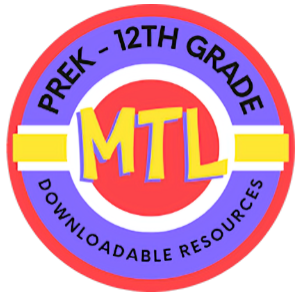Showing 21–40 of 663 resultsSorted by latest
-
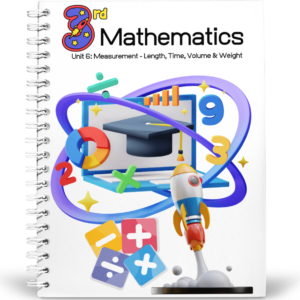 $4.50Buy Now
$4.50Buy NowIn this unit, students measure length, weight, liquid volume, and time. They begin with a study of length measurement, building on their recent work with fractions. Students will explore length measurements in halves and fourths of an inch. They use a ruler to collect measurements and then display the data on line plots, learning about mixed numbers and revisiting equivalent fractions along the way. Next, students learn about standard units for measuring weight (kilograms and grams) and liquid volume (liters). To build a sense of weights such as 1 gram or 1 kilogram, students hold common objects such as paper clips and bottles of water. From there, students move on to measure time. In the final section of the unit, students make sense of and solve problems related to all three measurements. The work here allows students to continue to develop their fluency with addition and subtraction within 1,000 and understanding of properties of operations. It also prompts them to use the relationship between multiplication and division to solve problems.
Includes: Student and Teacher Editions
Size: 228 pages -
 $5.00Buy Now
$5.00Buy NowIn this unit, students will learn about fractions, naming parts, building from units, locating on a number line, equivalent fractions, and how to compare fractions with the same denominator and the same numerator.
Includes: Student and Teacher Editions
Size: 338 pages -
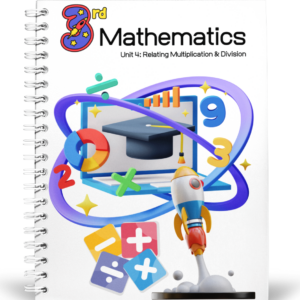 $6.00Buy Now
$6.00Buy NowThis unit introduces students to the concept of division and its relationship to multiplication. Previously, students learned that multiplication can be understood in terms of equal-size groups. The expression 5 x 2 can represent the total number of objects when there are 5 groups of 2 objects, or when there are 2 groups of 5 objects. Here, students make sense of division also in terms of equal-size groups. For instance, the expression 30 ÷ 5 can represent putting 30 objects into 5 equal groups, or putting 30 objects into groups of 5. They see that, in general, dividing can mean finding the size of each group, or finding the number of equal groups. Students use the relationship between multiplication and division to develop fluency with single-digit multiplication and division facts. They continue to reason about products of two numbers in terms of the area of rectangles whose side lengths represent the factors, decomposing side lengths and applying properties of operations along the way. As they multiply numbers greater than 10, students see that it is helpful to decompose the two-digit factor into tens and ones and distribute the multiplication. Toward the end of the unit, students solve two-step problems that involve all four operations.
Includes: Student and Teacher Editions
Size: 431 pages -
 $5.00Buy Now
$5.00Buy NowIn this unit, students work toward the goal of fluently adding and subtracting within 1,000. They use mental math strategies developed in grade 2 and learn algorithms based on place value. Students work with a variety of algorithms, starting with those that show expanded form, and moving toward algorithms that are more streamlined and closer to the standard algorithm. Understanding of place value also comes into play as students round numbers to the nearest multiple of 10 and 100. Students do not need to know a formal definition of “multiples” until grade 4. At this point, it is enough to recognize that a multiple of 10 is a number called out when counting by 10, or the total in a whole-number of tens (such as 8 tens). Likewise, a multiple of 100 is a number called out when counting by 100, or the total in a whole-number of hundreds (such as 6 hundreds). Students use rounding to estimate answers to two-step problems and determine if answers are reasonable.
Includes: Student and Teacher Editions
Size: 374 pages -
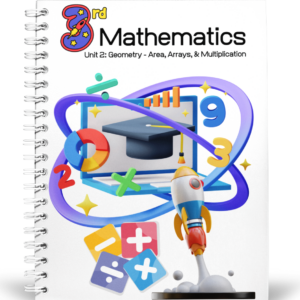 $5.00Buy Now
$5.00Buy NowIn this unit, students encounter the concept of area, relate the area of rectangles to multiplication, and solve problems involving area. Students make sense of another attribute of shapes: a measure of how much a shape covers. They begin informally, by comparing two shapes and deciding which one covers more space. Later, they compare more precisely by tiling shapes with pattern blocks and square tiles. Students then focus on the area of rectangles. They notice that a rectangle tiled with squares forms an array, with the rows and columns as equal-size groups. This observation allows them to connect the area of rectangles to multiplication—as a product of the number of rows and number of squares per row. To transition from counting to multiplying side lengths, students reason about area using increasingly more abstract representations. They begin with tiled or gridded rectangles, move to partially gridded rectangles or those with marked sides, and end with rectangles labeled with their side lengths. Students also learn some standard units of area—square inches, square centimeters, square feet, and square meters—and solve real-world problems involving area of rectangles. Later in the unit, students find the area and missing side lengths of figures composed of non-overlapping rectangles.
Includes: Student and Teacher Editions
Size: 306 pages -
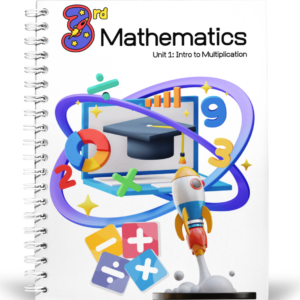 $5.00Buy Now
$5.00Buy NowIn this unit, students ready to learn multiplication will interpret and represent data on scaled picture graphs and scaled bar graphs and then they will learn the concept of multiplication! Students explore scaled picture graphs and bar graphs as an entry point for learning about equal-size groups and multiplication. The idea that one picture can represent multiple objects helps to introduce the idea of equal-size groups. Students learn that multiplication can mean finding the total number of objects in groups of objects each, and can be represented by a x b. They then relate the idea of equal groups and the expression a x b to the rows and columns of an array. In working with arrays, students begin to notice the commutative property of multiplication. In all cases, students make sense of the meaning of multiplication expressions before finding their value, and before writing equations that relate two factors and a product. Later in the unit, students see situations in which the total number of objects is known but either the number of groups or the size of each group is not known. Problems with a missing factor offer students a preview to division.
Includes: Student and Teacher Editions
Size: 369 pages -
 $5.00Buy Now
$5.00Buy NowThis unit introduces students to standard units of lengths in the metric and customary systems: centimeters, meter, inches, and feet. They examine how different measuring tools represent length units, learn how to use the tools, and gain experience in measuring and estimating the lengths of objects. Along the way, students notice that the length of the same object can be described with different measurements and relate this to differences in the size of the unit used to measure. Throughout the unit, students solve one- and two-step story problems involving addition and subtraction of lengths. To make sense of and solve these problems, they use previously learned strategies for adding and subtracting within 100, including strategies based on place value. To close the unit, students learn that line plots can be used to represent numerical data. They create and interpret line plots that show measurement data and use them to answer questions about the data. Students relate the structure of a line plot to the tools they used to measure lengths. This prepares students for the work in the next unit, where they interpret numbers on the number line as lengths from 0. The number line is an essential representation that will be used in future grades and throughout students’ mathematical experiences.
Includes: Student and Teacher Editions
Size: 372 pages -
Sale!
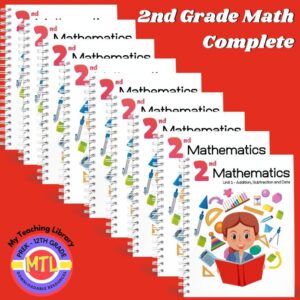 Buy Now
Buy Now$45.00Original price was: $45.00.$35.00Current price is: $35.00.2nd Grade Math Complete is a 9 unit program that covers all of the important skills and concepts typically covered in 2nd grade. Each unit includes the student and teacher edition. This resource can be used within a classroom setting, co-op or with individual students. Because it can be used within a group setting, you’ll find many activities for students to complete in pairs of 2. If you are homeschooling multiple children close in age, it would be easy to adapt and teach students together. If you are homeschooling a single child, you can easily adapt these activities through your one-on-one interaction!
You do not need to use the entire program if you are only wanting to focus on one or a few specific Math skills and concepts. If this is the case, you can purchase each unit separately.
Units:
- – Unit 1: Adding & Subtracting + Working with Data
- – Unit 2: Adding & Subtracting within 100
- – Unit 3: Measuring (Length)
- – Unit 4: Working with Number Lines
- – Unit 5: Working with Numbers to 1,000
- – Unit 6: Shapes, Time and Money
- – Unit 7: Adding & Subtracting to 1,000
- – Unit 8: Arrays: Even/Odd, Geometry & Multiplication Readiness
- – Unit 9: Review: 2nd Grade Level Skills & Concepts
-
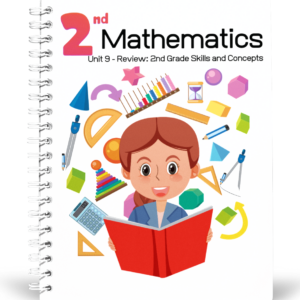 $4.50Buy Now
$4.50Buy NowIn this unit, students revisit major work and fluency goals of the grade, applying their learning from the year. Section A gives students a chance to solidify their fluency with addition and subtraction within 20. In section B, students apply methods they used with smaller numbers to add and subtract numbers within 100. In the final section, students interpret, solve, and write story problems involving numbers within 100, which further develop their fluency with addition and subtraction of two-digit numbers. They work with all problem types with the unknown in all positions.
Includes: Student and Teacher Editions
Size: 233 pages -
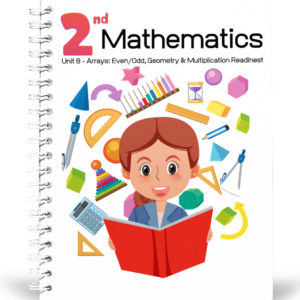 $5.00Buy Now
$5.00Buy NowIn this unit, students develop an understanding of equal groups, building on their experiences with skip-counting and with finding the sums of equal addends. The work here serves as the foundation for multiplication and division in grade 3 and beyond. Students begin by analyzing even and odd numbers of objects. They learn that any even number can be split into 2 equal groups or into groups of 2, with no objects left over. Students use visual patterns to identify whether numbers of objects are even or odd. Next, students learn about rectangular arrays. They describe arrays using mathematical terms (rows and columns). Students see the total number of objects as a sum of the objects in each row and as a sum of the objects in each column, which they express by writing equations with equal addends. They also recognize that there are many ways of seeing the equal groups in an array. Later, students transition from working with arrays containing discrete objects to equal-size squares within a rectangle. They build rectangular arrays using inch tiles and partition rectangles into rows and columns of equal-size squares. The work here sets the stage for the concept of area in grade 3.
Includes: Student and Teacher Editions
Size: 263 -
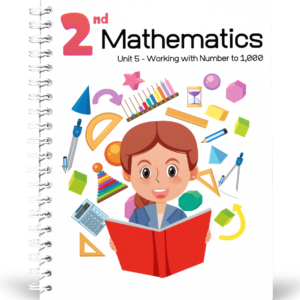 $5.00Buy Now
$5.00Buy NowIn this unit, students extend their knowledge of the units in the base-ten system to include hundreds. They learn that a hundred is a unit made up of 10 tens, and three-digit numbers are formed using units of hundreds, tens, and ones. To make sense of numbers in different ways and to build flexibility in reasoning with them, students work with a variety of representations: base-ten blocks, base-ten diagrams or drawings, number lines, expressions, and equations. At the start of the unit, students express a quantity in terms of the number of units represented by base-ten blocks. Next, students make sense of three-digit numbers on the number line.
Includes: Student and Teacher Editions
Size: 287 -
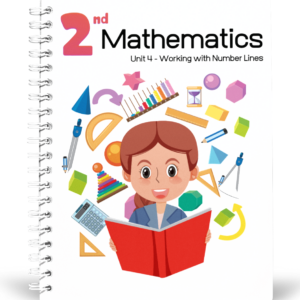 $5.00Buy Now
$5.00Buy NowIn this unit, students are introduced to the number line, an essential representation that will be used throughout students’ K–12 mathematical experience. They learn to use the number line to represent whole numbers, sums, and differences. They see that the tick marks and numbers on the number line are like those on a ruler: both show equally spaced numbers that represent lengths from 0. Students use this understanding of structure to locate and compare numbers on the number line, as well as to estimate numbers represented by points on the number line. Students then learn conventions for representing addition and subtraction on the number line: using arrows pointing to the right for adding and arrows pointing to the left for subtracting. Students also use the number line to represent addition and subtraction methods discussed in Number Talks, such as counting on, counting back by place, and decomposing a number to get to a ten. The reasoning here deepens students’ understanding of the relationship between addition and subtraction.
Includes: Student and Teacher Editions
Size: 309 -
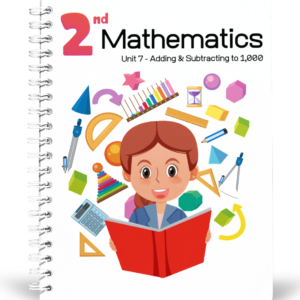 $5.00Buy Now
$5.00Buy NowIn this unit, students add and subtract within 1,000, with and without composing and decomposing a base-ten unit. They apply the methods they know and their understanding of place value and three-digit numbers to find sums and differences within 1,000. Initially, students add and subtract without composing or decomposing a ten or hundred. Instead, they rely on methods based on the relationship between addition and subtraction and the properties of operations. They make sense of sums and differences using counting sequences, number relationships, and representations (number line, base-ten blocks, base-ten diagrams, and equations). As the unit progresses, students work with numbers that prompt them to compose and decompose one or more units, eliciting strategies based on place value. Students learn to recognize when composition or decomposition is a useful strategy when adding or subtracting by place. In the later half of the unit, they encounter lessons that encourage them to think flexibly and use strategies that make sense to them based on number relationships, properties of operations, and the relationship between addition and subtraction.
Includes: Student and Teacher Editions
Size: 396 -
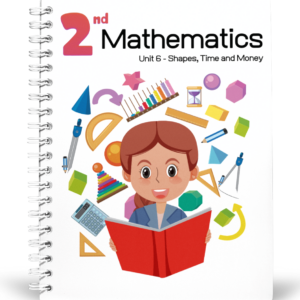 $6.00Buy Now
$6.00Buy NowIn this unit, students transition from place value and numbers to geometry, time, and money. They continue to look at attributes of a variety of shapes and see that shapes can be identified by the number of sides and vertices (corners). Students then study three-dimensional (solid) shapes, and identify the two-dimensional (flat) shapes that make up the faces of these solid shapes. Next, students look at ways to partition shapes and create equal shares. They extend their knowledge of halves and fourths (or quarters) from grade 1 to now include thirds. As they develop the language of fractions, students also recognize that a whole can be described as 2 halves, 3 thirds, or 4 fourths, and that equal-size pieces of the same whole need not have the same shape. Later, students use their understanding of halves and fourths (or quarters) to tell time. To continue to build fluency with addition and subtraction within 100, students conclude the unit with a money context.
Includes: Student and Teacher Editions
Size: 501 pages -
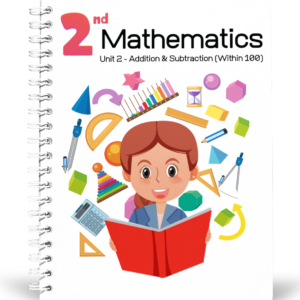 $5.00Buy Now
$5.00Buy NowIn this unit, students add and subtract within 100 using strategies based on place value, the properties of operations, and the relationship between addition and subtraction. Students begin by using any strategy to find the value of sums and differences that do not involve composing or decomposing a ten. They are then introduced to base-ten blocks as a tool to represent addition and subtraction and move towards strategies that involve composing and decomposing tens. Students develop their understanding of grouping by place value, and begin to subtract one- and two-digit numbers from two-digit numbers by decomposing a ten as needed. They apply properties of operations and practice reasoning flexibly as they arrange numbers to facilitate addition or subtraction. At the end of the unit, students apply their knowledge of addition and subtraction within 100 to solve one- and two-step story problems of all types, with unknowns in all positions. To support them in reasoning about place value when adding and subtracting, students may choose to use connecting cubes, base-ten blocks, tape diagrams, and other representations learned in earlier units and grades.
Includes: Student and Teacher Editions
Size: 336 pages -
 $5.00Buy Now
$5.00Buy NowIn this unit, students begin to develop (or review) fluency with sums and differences within 20, building on concepts of addition and subtraction that they covered while covering 1st grade skills and concepts. They learn new ways to represent and solve problems involving addition, subtraction, and categorical data. Students are introduced to picture graphs and bar graphs as a way to represent categorical data. They ask and answer questions about situations described by the data. The structure of the bar graphs paves the way for a new representation, the tape diagram. Students learn that tape diagrams can be used to represent and make sense of problems involving the comparison of two quantities. The diagrams also help to deepen students’ understanding of the relationship between addition and subtraction.
Includes: Student and Teacher Editions
Size: 376 pages -
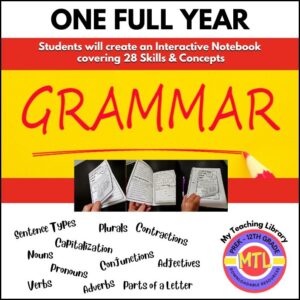 $12.00Buy Now
$12.00Buy NowThis resource provides a full year of grammar activities! Designed for 3rd grade students (or advanced 2nd grade or 4th graders who need additional practice), students will find 28 booklets covering important grammar skills. Each booklet will provide information and examples of the skill/concept for students to review. Students will then practice and implement the skill, show real world examples of the skill and then reflect and write in their own words what they have learned. Once each booklet is complete, they will then glue into a spiral notebook. At the end of the year, they will have a notebook full of grammar work! (See description below for a list of skills covered.)
-
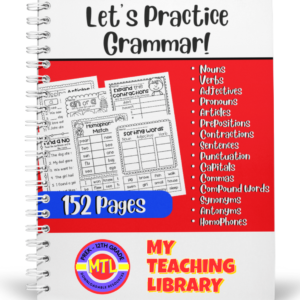 $8.00Buy Now
$8.00Buy Now- Let’s Practice Grammar includes over 150 pages of fun worksheets for students to practice and demonstrate their understanding of a variety of important grammar skills and concepts!
Including:
Nouns
Verbs
Adjectives
Pronouns
Articles
Prepositions
Contractions
Sentences
Punctuation
Capitalization
Commas
Compound Words
Synonyms
Antonyms
Homophones
- Let’s Practice Grammar includes over 150 pages of fun worksheets for students to practice and demonstrate their understanding of a variety of important grammar skills and concepts!
-
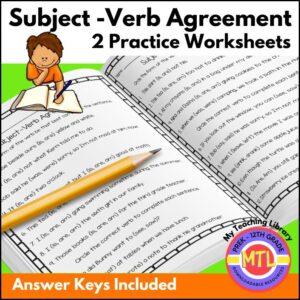 $1.25Buy Now
$1.25Buy NowTwo worksheets (with answer keys) to give students the opportunity to demonstrate their knowledge of subject-verb agreement in simple sentences. Students will identify and circle the correct form of the verb ‘be’ as well as forms of other verbs such as see/saw, leave/left/drink/drank, win/won, sit/sat, write/wrote.
-
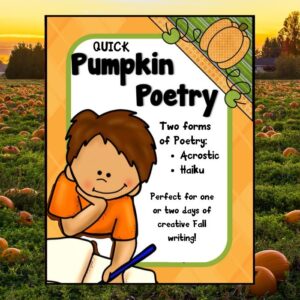 $1.00Buy Now
$1.00Buy NowThis resource is perfect for fun and quick poetry writing during the Fall! Students can write one or two different forms of poetry, acrostic and haiku, on pumpkin designed pages! The resource also includes an informational page about pumpkins.
